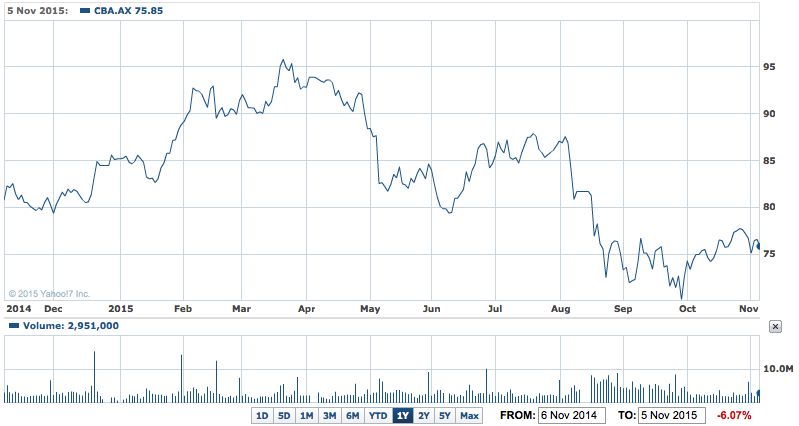A mere half per cent rise in cash earnings for the September quarter won’t be enough, if repeated, in the current quarter to give shareholders in the Commonwealth Bank (CBA) hopes for second big increase in interim dividend when the half year result is announced next February.
The Commonwealth yesterday reported a cash profit of $2.4 billion in the first quarter, as the bank’s net interest margin contracted slightly and another fall in bad debts.
That was a 0.5% on the $2.3 billion it made in the same quarter last year.
CBA shares fell 0.9% to $75.85, in line with the fall in the wider market.
The trading update contained limited information, compared with the interim and full year results, but it was enough to suggest that the bank has started 2015-16 on a sedate note so far as growing earnings is concerned.
CBA told the market its expense for impaired loans was 0.13% of assets in the quarter, compared with 0.16% in the year to June. It said the group’s net interest margin was "slightly lower" because the bank was holding more liquid assets, and trading income was lower than average.
CBA said household deposit growth had been “strong” and faster than the market, while its home lending was in line with recent growth rates. (but actual growth figures were not given).
CBA said its troublesome and impaired loans fell to $5.5 billion, down from $6 billion in the previous quarter. ”Credit quality remained sound, with arrears levels reducing across all consumer portfolios in line with seasonal expectations,” the bank added. For that it can thank the two interest cuts this year which have taken the pressure off customers, especially in housing.
The half a per cent rise is on of the smallest the bank has reported for a quarter for years and it raises the very real prospect that it will find it very tough to raise interim dividend next year.
Both the NAB and the ANZ maintained a steady final dividend for 2014-15 for varying reasons including a slide in earnings in the half or uncertainty about the outlook.
CBA 1Y – CBA profit lifts but NIM slims

The CBA’s full year dividend in 2014-15 rose 5% to $4.20 a share – but the 5% rise in the final was less than half the 12% jump in the interim (from $1.98 to $2.22 a share). That 12% rise won’t be repeated next year, based on the first quarter result.
And shareholders in the CBA and other banks would do well to heed yesterday’s comments on bank shareholder returns from Reserve Bank Governor, Glenn Stevens. The central bank wants to see shareholders share the cost of the higher capital needs of the banks, not just customers who have been slugged by the banks recently.
Mr Stevens said in a speech in Melbourne that “an assumption that shareholder returns must not decline as a result of the effects of supervisory measures or any other factor” should not “simply be accepted without question”.
"The ‘right’ rate of return for bank shareholders is, as others have observed, an open question. It is not a constant of the universe,” he said in his speech.
This is the third time the bank has made the point in recent weeks, so we can be assured it is a top issue. In fact there’s seems to be a strong feeling among regulators that the banks can’t be trusted at the moment.
The poor record keeping and dud processes for monitoring home lending is also a worrying issue for the bank, as Deputy Governor, Phil Lowe made clear in comments to a separate function in Sydney yesterday.
Many of the problems with the banks’ record keeping in their domestic housing books were exposed when APRA and ASIC went into the banks in the first quarter of this year for a close look at just what was happening with investor lending. What was found shocked the investigators in many cases.
As a result, bank regulators (RBA and APRA) plus the Bureau of Statistics are going to overhaul all housing statistics next year because of the weak reporting performance of even the biggest banks (ANZ and NAB according to media reports earlier this year). That will add to the banks’ costs.












